Nitrogen (N) fertilizer use is the largest in the crop sector, an important sector, where current annual consumption is 1190 Gg. The present combined annual Nr production from crop, fishery, and livestock sectors is ~600 Gg, while emissions of nitrous oxide (N2O), a potent greenhouse gas, are ~200 Gg. Poor N management results in Nr leaking into the environment, which has increased approximately 16-fold since 1961. One potential consequence is the disruption of ecosystem functioning. The balanced tradeoff between food production and reducing Nr input needs to be achieved. One solution to reducing unutilized reactive N (Nr) may be a holistic approach that optimizes N application rates and incorporates waste of one subsector as an input to another applying the principle of the circular economy.
- isheries
- livestock sectors
- N2O
- manure
- sustainable N management
1. Introduction
2. Reactive Nitrogen Flows in Bangladesh’s Agriculture Sector
2.1. Nitrogen Fertilizer Consumption, Production, and Import in Bangladesh
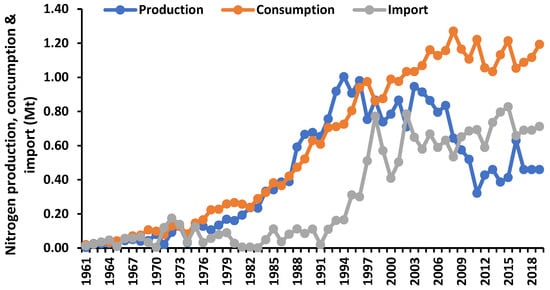
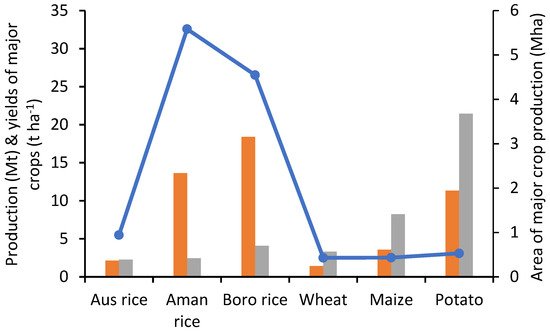
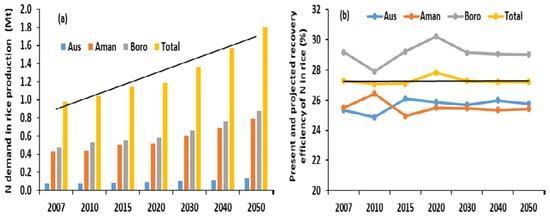
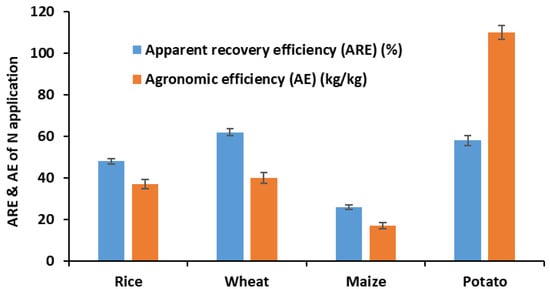
2.2. Reactive N (Nr) Production in Bangladesh’s Agriculture
Significant proportions of N fertilizer applied for crop production are subject to loss to the atmosphere. The release of Nr from N fertilizer as NH3, N2O, and NO in Bangladesh since 1961 to 2019 has increased dramatically (Figure 5a). From 1961 to 2019, emissions of NH3, N2O, and NO from N fertilizer increased from 4.72 to 263.45, 0.68 to 37.95, and from 0.28 to 15.65 Gg, respectively. This magnitude of loss of Nr from inorganic N fertilizer is of serious concern for agricultural and environmental sustainability. Production of Nr and its losses to the environment have increased in recent years mostly because of higher rates of N fertilizer application coupled with low use efficiency.

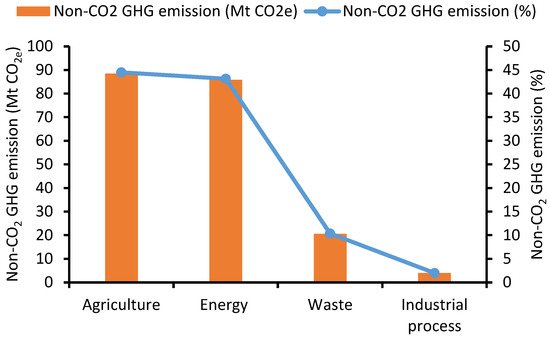
2.3. Nitrogen Use and Nr Production in Aquaculture
Fish provide 60% of the animal protein to the people of Bangladesh [46]. During the recent decades, aquaculture ventures have increased and intensified. The shift from low-input, extensive systems to high-input, intensive aquaculture systems has resulted in a huge demand for fish feed. Total feed production for pond aquaculture in 2008 was only 0.67 Mt, which increased 400 times to 2.66 Mt in 2017 (Figure 7a). Total feed comprises sinking, floating, and farm-made feeds, which contributed a total of 37,520 t of N in 2008, increasing to 148,960 t in 2017. Mamun-Ur-Rashid et al. [45] reported that the production and sale of fish feed in Bangladesh’s aquaculture have increased radically in the last decade, where about 1.04 Mt of feed was produced commercially and between 0.3 and 0.4 Mt was produced at th village level with additional imports needed. Actual feed requirements are higher than local production. Raw unformulated feeds such as rice bran and mustard oil cake are applied to fishponds. Farmers in Bangladesh apply 1000 t of raw and unprocessed feed in their ponds annually [66]. This is included in farm-made feed in Figure 7a. Mamun-Ur-Rashid et al. [45] also reported that, since 2008, feed production has increased by 32% annually to approximately 3.0 Mt in 2017. Other data led to a fish feed requirement estimation of 2.65 Mt in 2017 in Bangladesh [47]. Fish feed serves as an important input of Nr in the aquaculture sector of the country, and cultured fish ponds released 675 t of N2O in 2008 and 2681 tons in 2017 (Figure 7b). Total ammonia (NH4+ and NH3) production in fish ponds was 21,574 and 85,652 t in 2008 and 2017, respectively (Figure 7b). Unaccounted-for loss of N was calculated to be 4014 t in 2008 and 20,587 t in 2017.
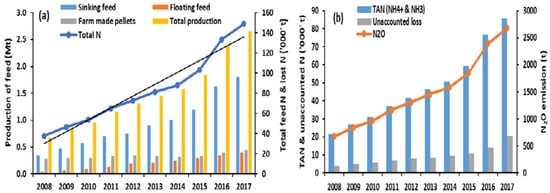
2.4. Manure N and Nr Production from Livestock and Poultry
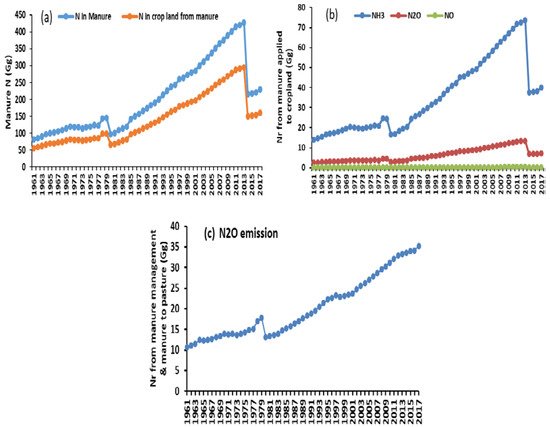
This entry is adapted from the peer-reviewed paper 10.3390/su14010272
